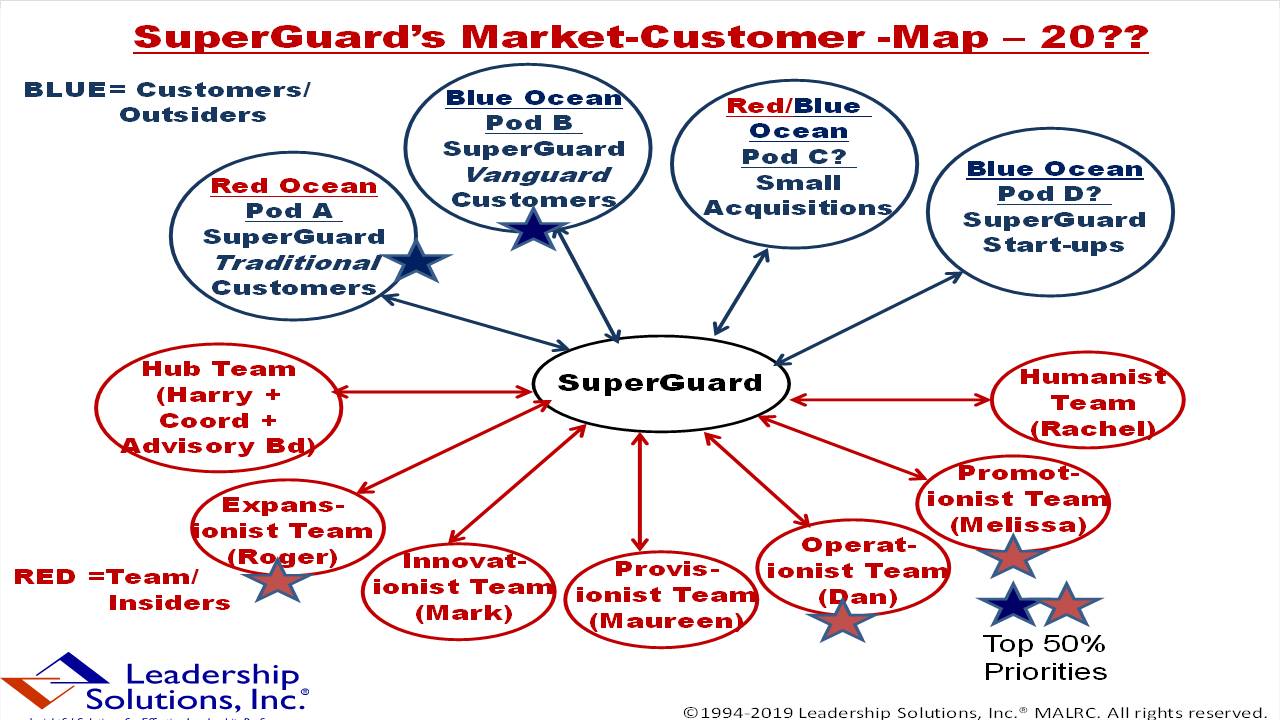by Peter A. Arthur-Smith, Leadership Solutions, Inc.®
“Mapping and knowing how to engage your external and internal constituents is key to success.”

Harry agreed with Christine the day after the Strategists’ Periscope Time daylong session – where they upgraded SuperGuard’s Vision and Positioning – on the absolute need to sustain and encourage momentum. He therefore polled his Strategist team on their likely availability over the next ten days; including sharing his reasons for another early session. His consensus poll ended-up with Tuesday morning of the following week.
He subsequently emailed a short briefing paper outlining the intent and likely issues for them to think about during the meantime. He also pointed out his desire for them to sharpen clarity on who were SuperGuard’s external and internal constituents in order to fully engage them. Engagement happens through focusing on the right level of direct or indirect constituent involvement and effectively serving their realistic interests.
When the Strategist team did gather again, it created the above pictograph – a map of the company’s external (blue) and internal (red) constituents. They’re arranged like this to emphasize the need for an “outside-in,” constituent focused venture. Also, the need for regular two-way communication to remain optimally attuned to each other’s expectations.
In addition to the SuperGuard Traditional and Vanguard pods (A &B), you can also spot their future intent to make small, related acquisitions (Pod C) and establish further Blue Ocean start-ups (Pod D). These will happen according to “internal” funding and leadership talent being available – rather than rushing to the bank or equity investors to fund such intentions. The latter options ought to be among their last rather than first intentions. In the meantime, they would devote their energies and talents toward providing extraordinary service and support to Pod A & B customers to aid innate expansion.
At this meeting moment, they decided to split into two sub-teams – Roger, Maureen and Melissa in one, and Mark, Dan and Rachel in the other – to discuss how well SuperGuard was serving their Traditional and Vanguard customers. This was helped by a great deal of documented customer feedback gathered by Melissa’s sales team. Harry and Christine listened in on these two sub-team discussions over the next 45 minutes and offered objective input where appropriate.
When the two groupings re-convened to compare notes, both agreed that their current, trial-run Vanguard customer would be smiling with satisfaction and therefore a great referral. On the other hand, after some debate, they agreed that their Pod A Traditional customers would give SuperGuard an overall rating somewhere between a straight-face K and a smiling-faceJ. This sparked Dan, SuperGuard’s Operationist and interim Pod A Visionist, to agree on the need for pulling his team leaders (TLs) together soonest for a series of In-Team Discovery sessions.
Such activities would encourage those TLs to pinpoint where Traditional’s pod teams were doing well and where they could do better. By using self-discovery his team leaders would be much more committed to reinforce their strengths and figure-out where progress needed to be made. This approach differs considerably from the conventional management approach, where beating the drum of what people do wrong typically occurs…with relatively little emphasis on what they do right. The latter encourages people to do even better.
By taking a strengths-progress approach, they would then pinpoint areas for additional team member or “pair” education and skill upgrades. Dan would then be assured to follow-through, on a regular basis, to ascertain progress and commitment until his pod A gets much closer to a smiling-face. By doing so, his teams would then be much better placed to stand-out in a “red ocean” marketplace; as well as gain more referrals.
Even though Roger’s Vanguard teams – through his interim Visionist Pod leadership – felt good about their customer smiling-faceJ; he agreed to hold regular progress meetings to encourage optimum customer attentiveness. That attentiveness had to occur without going overboard and keeping both SuperGuard’s and their customer’s expectations in balance. This also meant learning more about how to optimize Vanguard’s novel services when it came to future customer expansion. In particular, Roger would have to be vigilant about putting the right people in place and constantly, but constructively, bolstering individual and “pair” competence levels. This was music to Rachel’s ears – SuperGuard’s Humanist…and Harry and Christine’s, too.
Since this was more of an ad-hoc meeting to follow-through on their recent Periscope Time session, they had a light sandwich and coffee/tea lunch. They parted company when they agreed on another meeting within the next ten days to consider-decide on their Collaborate and Teamwork (Phase 4) activities; all vital toward sustaining momentum. There was no push back against a further session, since it made absolute sense and they thoroughly enjoyed collaborating on these enlightened leadership growth activities.
__________________________________________________________________
Author, Peter A. Arthur-Smith, Founding Principal with Leadership Solutions, Inc., is based in New York, and author of Smart Decisions: Goodbye Problems, Hello Options. He has drafted a potential new publication, Leadership Re-Envisioned: How to Assure People Count more than Numbers? It offers a slew of fresh leadership concepts and practical models. Feel free to follow author at: Linkedin.com/in/peter-arthur-smith-2115722/
© 2022 Leadership Solutions, Inc –MALRC. All rights reserved.
